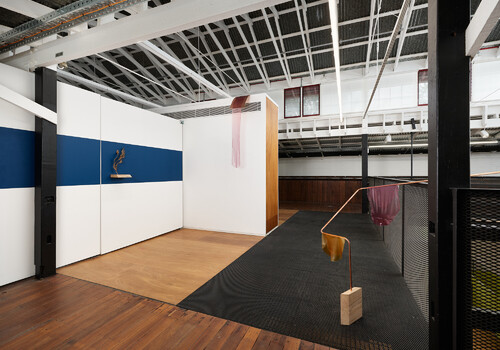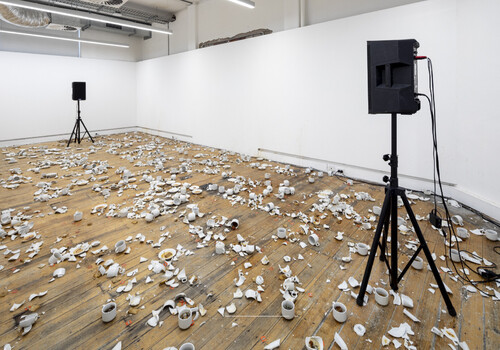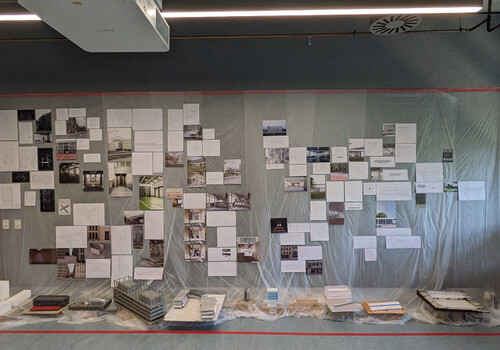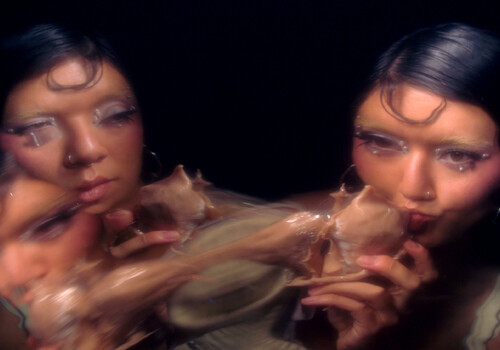Sculpture, National Art School
By Rosario Aguirre
One of my favourite kinds of art is art that doesn’t even seem to be art. To make work that challenges what art should look like or be made of—sometimes even to the point where you can’t tell if you’re looking at an artwork—also appears to amuse National Art School sculpture graduates, whose work is on view at their annual grad exhibition.

Installation view of Nikki Poulos, THIS IS NOT AN ARTWORK, 2024, found display stand, paper, text, 110 x 40 x 40 cm, National Art School, Sydney, https://gradshow24.nas.edu.au/collections/nikki-poulos/products/this-is-not-an-artwork. Photo: Courtesy of the artist.
Take, for instance, the official NAS-branded bollard sign placed in front of a washing station. In the anything-goes ambience of the grad show, chances are this casual grouping of plastic jugs in a utility sink might be assumed to be a sculptural piece––as I initially thought. “THIS IS NOT AN ARTWORK,” the sign declares. It takes me a moment to realise that the artwork here is, in fact, the sign itself. Artist Nikki Poulos playfully engages with art’s capacity to expand traditional boundaries, involving not only unconventional artistic materials but also its surroundings. Poulos’s work moves everyday objects and scenes into an ambiguous space between art and non-art. Through a statement that seeks to delimit artistic interpretation, this cleverly staged work appears to compete with the art institution’s attempts to do the same.

Ruby McVicar, Perfect, 2024, plastic bags, push pins, metal rack, bag of oranges, plastic heels, 100 x 100 x 100 cm, National Art School, Sydney, https://gradshow24.nas.edu.au/collections/ruby-mcvicar/products/perfect. Photo: Courtesy of the National Art School.
Ruby McVicar’s Perfect (2024) also embraces an unglamorous mundanity. Two clear, medium-sized plastic bags hang pinned side by side to the wall. Below, a bag of oranges sits on a metal rack alongside a pair of plastic, worn-down heels. The elements and their arrangement suggest a bodily, female presence. Upon closer examination, the thin skins of the bags subtly vibrate, responding to the faintest breeze from one’s proximity. Quite delicately, the plastic’s transparency against the white backdrop gives it a somewhat ethereal aura, while the work’s hardly coincidental dimensions of 100 x 100 x 100 cm further contribute to the exploration of traditional notions of perfection. McVicar negotiates fragility, ephemerality and the synthetic, offering a renewed construction of femininity that opposes classical Western representations of the female form in sculpture.

Installation view of Amelia Rose, Facade, 2024, copper, copper brackets, silicon, 24 x 110 x 20 cm, National Art School, Sydney, https://gradshow24.nas.edu.au/collections/amelia-rose/products/turn. Photo: Courtesy of the artist.
When it comes to blurring the lines between the everyday and art, Amelia Rose’s installation serves as a case in point. Site-specificity all the way through: debris from scratched wall painting revealing sandstone, a curled-up floor linoleum corner, copper-coiled pipes, metal rods––all easily mistaken for building interiors. Rose’s sculptural work demands a close, physical engagement, as it seamlessly blends with and responds to the space. It draws attention to its intrinsic details and transformation over time. The work offers a new way of seeing the building, exposing its readily available information and making it come alive, as if it would want to speak to us and share its layered secrets, its lived history and what it’s made of.
On my way out of the sculpture section, I nearly missed that smaller room dedicated to Rose’s work––reflecting the difficulty of telling her art apart from the space itself. So make sure you don’t, and thank me later.
Rosario Aguirre is an emerging arts worker from Chile, currently based in Eora/Sydney. She is completing a Master’s in Art Curating at the University of Sydney and building a career in the cultural sector.









































